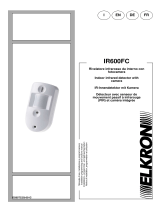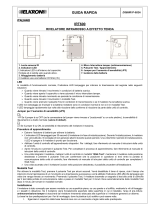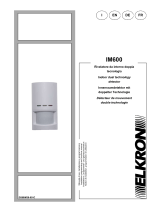Elkron DC6002I/BR magnetic contacts with wired inputs offer reliable protection for doors and windows. The built-in magnetic switch detects opening and closing, while the tamper switch protects against tampering attempts. Additional features include:
- Adjustable sensitivity for blind and roller shutter detectors (5, 6, or 8 pulses in 10 seconds)
- Wired inputs for connecting additional detectors, such as glass break detectors or motion detectors
- Test mode for easy testing of the device's functionality
- Low battery indication to ensure uninterrupted protection
Elkron DC6002I/BR magnetic contacts with wired inputs offer reliable protection for doors and windows. The built-in magnetic switch detects opening and closing, while the tamper switch protects against tampering attempts. Additional features include:
- Adjustable sensitivity for blind and roller shutter detectors (5, 6, or 8 pulses in 10 seconds)
- Wired inputs for connecting additional detectors, such as glass break detectors or motion detectors
- Test mode for easy testing of the device's functionality
- Low battery indication to ensure uninterrupted protection








-
 1
1
-
 2
2
-
 3
3
-
 4
4
-
 5
5
-
 6
6
-
 7
7
-
 8
8
Elkron DC6002I/BR Quick start guide
- Type
- Quick start guide
- This manual is also suitable for
Elkron DC6002I/BR magnetic contacts with wired inputs offer reliable protection for doors and windows. The built-in magnetic switch detects opening and closing, while the tamper switch protects against tampering attempts. Additional features include:
- Adjustable sensitivity for blind and roller shutter detectors (5, 6, or 8 pulses in 10 seconds)
- Wired inputs for connecting additional detectors, such as glass break detectors or motion detectors
- Test mode for easy testing of the device's functionality
- Low battery indication to ensure uninterrupted protection
Ask a question and I''ll find the answer in the document
Finding information in a document is now easier with AI
in other languages
- italiano: Elkron DC6002I/BR Guida Rapida
- français: Elkron DC6002I/BR Guide de démarrage rapide
- Deutsch: Elkron DC6002I/BR Schnellstartanleitung
Related papers
-
 Elkron IR600FC Quick start guide
Elkron IR600FC Quick start guide
-
 Elkron DC600/BR Installation guide
Elkron DC600/BR Installation guide
-
 Elkron DC600S/BR Installation guide
Elkron DC600S/BR Installation guide
-
 Elkron IR600FC Installation guide
Elkron IR600FC Installation guide
-
 Elkron IR600 Quick start guide
Elkron IR600 Quick start guide
-
 Elkron IRT600 Installation guide
Elkron IRT600 Installation guide
-
 Elkron IRT600 Quick start guide
Elkron IRT600 Quick start guide
-
 Elkron TT20AM Installation guide
Elkron TT20AM Installation guide
-
 Elkron IM600 Installation guide
Elkron IM600 Installation guide
-
 Elkron IR600FC/RF Installation guide
Elkron IR600FC/RF Installation guide
Other documents
-
urmet MK 1051-204 User manual
-
 Lince 4048GR868LESW Operating instructions
Lince 4048GR868LESW Operating instructions
-
Abus BW8040 Specification
-
CAME PROXINET Installation guide
-
Abus Xevox 360° Installation guide
-
AVS Electronics JET DT User manual
-
Marmitek DS831 User manual
-
Abus 4043158057676 Owner's manual
-
BFT Rigel5 Owner's manual
-
Comelit RF2PIRB Technical Manual


















